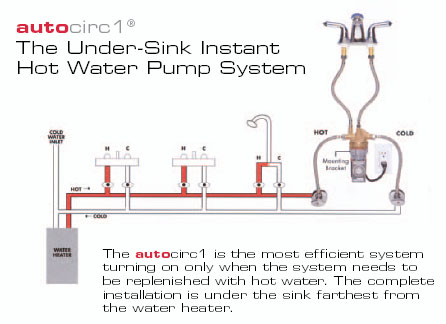|
||
|
how instant hot water systems work The problem of course is that water heated by your water heater sits in the line between the heater and the tap(s) where it cools off. Let's call this "previously hot" water. When you turn on the tap you need to flush out this previously hot water to get to the fresh hot stuff. With low-flow faucets and long plumbing runs, this can take a long time - and waste a lot of water. And it can cause problems for your appliances too - forcing washers and dishwashers to use more time and energy heating their own water (or worse, run with water not hot enough to clean). An instant hot water system - or hot water recirculation system - flushes the previously hot water back into the hot water tank (rather than you running it down the drain) so you have freshly heated water waiting for you when you turn on the faucet - instant hot water. Most instant hot water systems use the same basic approach - a special pump flushes previously hot water from the hot water line, sending it back to the heater through the cold water line. differences between systems Differences lie in how the systems are activated and how fast they work. The Laing AutoCirc E1 performs a flush whenever it senses the water temperature has fallen below a certain level; the Metland D'MAND systems are, as the name implies, "on demand" - a high-speed flush is triggered by either button or motion sensor.  demand vs automatic systems A demand system is the most efficient in terms of energy use; and it always provides freshly heated water - but it takes a few seconds (still way faster than running the tap though). On the other hand, automatic systems always have hot water at the ready and require no change in user behavior - however the water may be warmer or hotter depending on how recently the system performed a flush, and energy is not used as efficiently. How much do instant hot water systems save? Water savings for a household of four occupants varies from about 900 gallons to about 3000 gallons per point of use, per year (DOE study). Point of use is a single location at a home, for example a faucet where hot water is available. The water savings in a home with four points of use, on the average, would be 3,600 to 12,000 gallons per year. So, conservatively, if your home saved only 20 gallons of water each day (7,300 gallons per year) then in one year you could save between $100 and $200, considering water, energy and sewage charges. Usage considerations Once installed, these systems are quiet, dependable and maintenance-free. Laing provides a 1 year warranty on their units while ACT Advanced Conservation Tech pump provides either a 3 or 5-year warranty depending on the pump. The ACT Advanced Conservation Tech systems are activated by users and so household members need to adapt their habits a bit (basically you just learn to hit the button as you walk into the bathroom). Installation considerations physical placement The pump units are located at the last fixture on your plumbing run. For example under a sink at the last bathroom on the plumbing run. If you are not sure of the layout of your plumbing, try following the pipes from the heater if that is possible - or call a professional plumber. plumbing These systems work with most typical residential plumbing configurations. However, there are a few considerations. First, if you have a tankless hot water heater, you must go with either the ACT C1-100 or Laing E10 tankless pumps. Second, if you have determined that your home has more than one plumbing run (a branched system) you will require multiple pump units (one for each branch). electrical All Laing and ACT Advanced Conservation Tech units units are low-wattage pumps that plug into standard 115v outlets. More Links: - All ACT Advanced Conservation Tech Pumps - All Laing Pumps As always, if you would like to ask more questions about this or other technical topics give us a call at 877-711-4822 - 9-5 PST. Live people for technical and sales support - an Internet first! |
HVACQuick.com
high performance ventilation & green products - large in-stock inventory!
- team@hvacquick.com
- 888-855-7229


